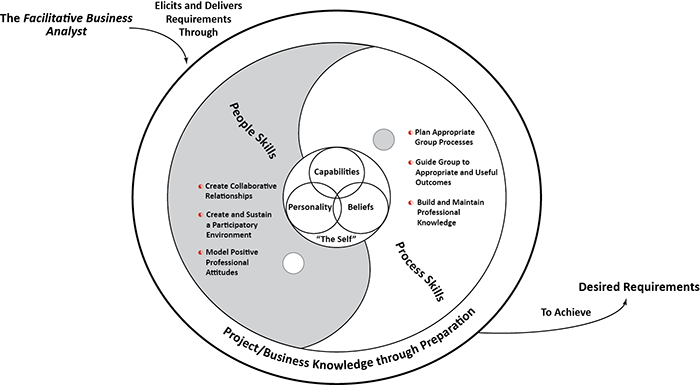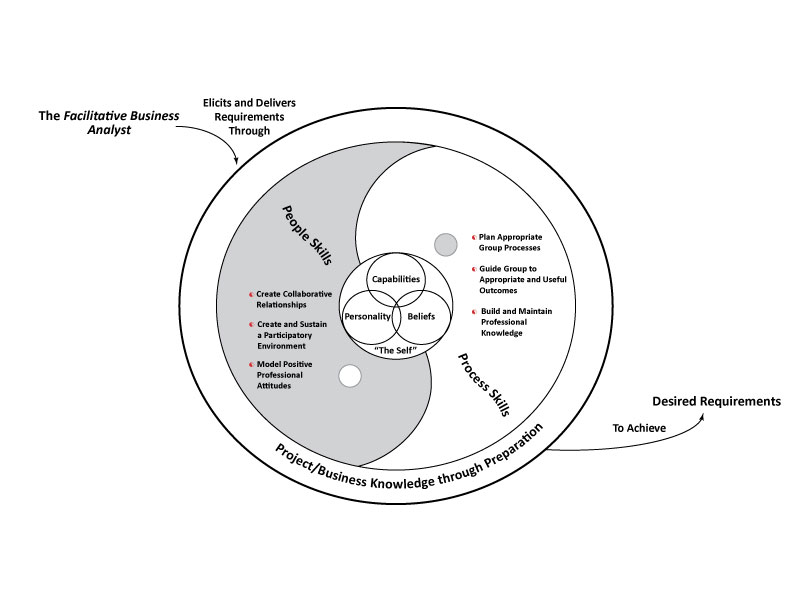
Why Can't a Business Analyst be Facilitative? | Gary Rush Facilitation
Introduction
Coming from an IT background, as a Business Analyst, Programmer, and Project Manager, I learned that the role of a Business Analyst was to understand both process and content. Business Analysts defined the requirements process, had to fully understand the business, gather requirements from the business stakeholder, and often made scope decisions – therefore, a Business Analyst could not be a Facilitator, the role violated neutrality. But, with the growth of Business Analysis, thanks to the International Institute of Business Analysis (IIBA), I have changed my view. “Why can’t a Business Analyst be Facilitative?” Business Analysts are more successful if they are able to guide their group through a facilitated process to accomplish their task. They produce better results that have the buy-in of all stakeholders enabling the greatest chance of success. Note: Effective group facilitation requires a Facilitator / Session Leader who knows both People and Process skills – “Structured Facilitation.”
International Institute of Business Analysis’ (IIBA’s) handbook for Business Analysts – A Guide to the Business Analysis Body of Knowledge (BABOK®) describes business analysis independently of what type of business the project is for. In other words, business analysis is business analysis – whether it’s for insurance, construction, marketing, or any other business.
Facilitator Role versus Business Analyst Role
Facilitator Role
“A Facilitator is a content neutral task-leader who forms a group of people into a collaborative team supporting consensus and uses a range of processes to enable the group to accomplish their task. The Facilitator is responsible for the context.” (Rush, 2013)
Looking at the definition, a Facilitator defines a process for a group that enables them to accomplish a task and then guides the group through the process to accomplish their task.
Effective Facilitators are able to seamlessly integrate the process to accomplish a task along with the emotional group cycle while considering the people’s characteristics. Facilitators are content neutral – that is, they must not contribute information or opinions regarding the subject matter or business being discussed. They do however, through preparation, provide effective processes for a group to follow. The effective processes brought by the Facilitator focuses the content knowledge brought by the group, enabling effective decision-making.
Facilitators are process experts – experts in the facilitation process.
Business Analyst Role
According to the BABOK® (IIBA version 2.0), “Business Analysis is the set of tasks, knowledge, and techniques required to identify business needs and determine solutions to business problems. Solutions often include a systems development component, but may also consist of process improvement or organizational change.”
Looking at the definition, Business Analysts are process experts – experts in analysis and requirements definition making them responsible for the context. It doesn’t state that they have to be content experts.
Rethinking the Role – The Facilitative Business Analyst
What’s required to do business analysis, as described, leads me to rethink the role and believe that a Business Analyst who uses facilitation skills and facilitates requirements can focus on the analysis process and be more effective.
Let’s look at the similarities between them:
- Facilitators are process experts – experts in the Facilitation process.
- Business Analysts are process experts – experts in analysis and requirements definition.
- Both are more knowledgeable about process than about content – they are content neutral.
Business Analysts gather requirements and analyze business and if analysis is analysis regardless of the type of business, then we can redefine the traditional view of the role of the Business Analyst.
Facilitative Business Analyst Core Competencies
To begin, let’s start with the IAF Core Facilitator Competencies (IAF, 2003):
- Create Collaborative Client Relationships.
- Plan Appropriate Group Processes.
- Create and Sustain a Participatory Environment.
- Guide Group to Appropriate and Useful Outcomes.
- Build and Maintain Professional Knowledge.
- Model Positive Professional Attitude.
Given that the two roles are similar, we can apply these core competencies to a Business Analyst as follows:
1. Create Collaborative Client Relationships.
Facilitator: This addresses the Facilitator’s relationship with the client. Does the Facilitator prepare properly by interviewing the client to define commitment, roles, and outcome?
Business Analyst: The Business Analyst must develop a collaborative relationship with their stakeholders to ensure the requirements meet their needs. They identify the appropriate stakeholders who know the business content providing effective information and requirements. This keeps the decision-making for scope, budget, and schedule with the stakeholders. Business Analysts prepare by interviewing their stakeholders to ensure that the business is well understood and the requirements meet their needs. This establishes a collaborative relationship.
2. Plan Appropriate Group/Analysis Processes.
Facilitator: This addresses the Facilitator’s ability to design and select the right processes and tools that deliver the desired outcome while supporting a diverse group of people, characteristics, and thinking styles to reach consensus.
Business Analyst: The Business Analyst needs to design and select the right processes and tools that deliver the desired requirements while supporting a diverse group of people, their characteristics, and thinking styles. Their knowledge of analysis defines the processes they follow. Facilitating stakeholders to develop the requirements gains ownership and buy-in. This buy-in makes the objectives achievable and clear because they were developed by and for the stakeholders.
3. Create and Sustain a Participatory Environment.
Facilitator: This addresses the ability of the Facilitator to manage communication, manage conflict, enable creativity, and encourage participation.
Business Analyst: The Business Analyst must manage communication, manage conflict, enable creativity, and encourage participation. Business Analysts must know “how to” actively listen, enable creativity, and manage conflict all while ensuring that everyone has an equal opportunity to participate. This develops better ideas from a more involved set of stakeholders and shares responsibility for success. Note: Understanding how groups evolve (Tuckman, 1965), how diversity impacts groups, and how people think and learn are important to creating and sustaining a participatory environment.
4. Guide Group/Project to Appropriate and Useful Outcomes.
Facilitator: This addresses the Facilitator’s ability to execute the designed processes, guide the group, stay on track, and achieve the desired outcome.
Business Analyst: The Business Analyst needs to execute the selected processes by guiding the group ensuring that barriers are removed. This enables and pushes the stakeholders to make content decisions, e.g., scope, time, cost, quality, and priorities providing more ownership, higher quality, and more agility in adapting the specifications, plans, and approaches. These are the skills related to the Business Analyst’s ability to execute the processes or adjust as needed in support of stakeholders. Note: Effective Business Analysts guide others ensuring that barriers are removed so that the stakeholders are able to effectively define their requirements.
5. Build and Maintain Professional Knowledge.
Facilitator: The Facilitator continues to be part of the profession and continues to learn new concepts and ideas.
Business Analyst: The Business Analyst must maintain professional knowledge through continuing education. They continue to learn new concepts of analysis, new processes, new concepts to engage stakeholders, and “how to” manage group dynamics. Business Analysts who use only one method become stagnant – they need to continue learning.
6. Model Positive Professional Attitude.
Facilitator: This addresses the Facilitator’s ability to remain neutral, act with integrity, and be self-aware.
Business Analyst: The Business Analyst must manage analysis, act with integrity, and be self-aware. They make facilitative business analysis contagious because they model what they practice. They set the tone.
These six competencies define the “Facilitative Business Analyst Core Competencies”.
The Mandala of the Facilitative Business Analyst

The Facilitative Business Analyst is a combination of his or her capabilities, personality, and beliefs – “The Self”. When Business Analysts practice Facilitative Business Analysis, they support their core competencies to achieve their project vision with: knowledge – being informed and prepared, actively listening to all stakeholders and enabling them to listen to each other, believing in the wisdom of the stakeholders and process creating a respectful, participatory environment.
The Facilitative Business Analyst is more flexible and agile in moving from one project to another because he or she, as a process expert, does not need to know the content. The Facilitative Business Analyst builds an effective relationship with stakeholders who:
- Know the business content.
- Bring content knowledge needed for the specific project.
- Work as a collaborative team.
- Take ownership of their requirements.
Making it Work
Creating Facilitative Business Analysis requires a change in how organizations view and train Business Analysts. Responsibility for the quality of requirements rests with all of the stakeholders. Organizations need to emphasize this.
Creating an environment that enables Facilitative Business Analysis requires:
- Business Analysts to be trained in effective Business Analysis skills. (The most effective way to do this is through training that enables a Business Analyst to become a Certified Business Analysis Professional (CBAP)).
- Business Analysts to be trained in effective Facilitation skills. (The most effective way to do this is through facilitation training to become an IAF Certified™ Professional Facilitator (CPF).)
- Redefining the role to focus on process so that responsibility is shared across all stakeholders – Facilitative Business Analysts are responsible for the analysis process and stakeholders are responsible for requirements quality.
- Involving stakeholders in all aspects of requirements definition so that stakeholders are making content decisions guided by the Facilitative Business Analyst.
By redefining the Business Analyst’s role as a Facilitative Business Analyst, the organization gains:
- Facilitative Business Analysts who are skilled at bringing stakeholders together to develop consensus and buy-in. Requirements are more successful as a result.
- Facilitative Business Analysts who focus on the right processes to:
- Identify requirements of the stakeholders.
- Establish clear and achievable objectives.
- Balance competing demands for quality, scope, time, and cost by involving the appropriate stakeholders.
- Inclusively adapt the requirements to the needs of the stakeholders.
Conclusion
Facilitative Business Analysts produce better results that have the buy-in of all stakeholders enabling the greatest chance of success. ![]()
"A Business Analyst should BE a Facilitative Business Analyst"
References
- International Association of Facilitators (IAF). (2000, Winter) "Facilitator Competencies". Group Facilitation: A Research and Applications Journal, Volume # 2 Number 2. Revised in February 2003.
- International Institute of Business Analysis (IIBA), A Guide to the Business Analysis Body of Knowledge (BABOK®) (IIBA Version 2.0), 2010.
- Rush, G., "Revisiting My Definition of a Facilitator", The FoCuSeD™ Facilitator eNewsletter, August 2013, Chicago, IL, MGR Consulting.
- Tuckman, B.W., “Development sequence in small groups”, Psychological Bulletin, Issue 63, pages 384-399, 1965.

